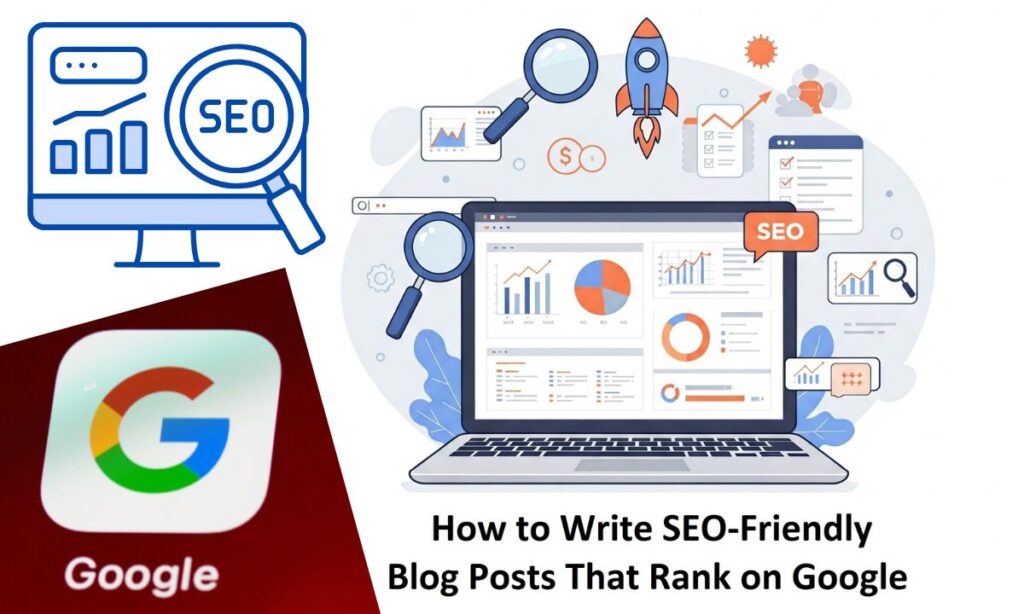How to Write SEO-Friendly Blog Posts That Rank on Google :
In today’s digital landscape, creating high-quality content is not enough—you need to ensure your blog posts are optimized for search engines. With millions of blogs published daily, standing out requires a strategic approach to SEO (Search Engine Optimization).
Whether you’re a beginner or an experienced blogger, mastering SEO-friendly writing can significantly boost your rankings on Google. In this comprehensive guide, we’ll explore actionable strategies to help you craft blog posts that attract organic traffic and engage readers.
Why SEO-Friendly Blog Posts Matter
Before diving into the “how,” let’s understand the “why.” SEO-friendly blog posts:
- Increase Visibility – Optimized content ranks higher on Google, making it easier for users to find you.
- Drive Organic Traffic – Ranking for relevant keywords brings free, consistent traffic.
- Enhance User Experience – Well-structured posts keep readers engaged, reducing bounce rates.
- Build Authority – High-ranking content establishes your brand as an industry leader.
Now, let’s break down the steps to writing SEO-friendly blog posts.
Step 1: Perform Keyword Research
Keyword research is the foundation of SEO. Without targeting the right keywords, your content may not reach the right audience.
How to Find the Best Keywords
- Use Keyword Research Tools – Tools like Google Keyword Planner, Ahrefs, SEMrush, and Ubersuggest help identify high-volume, low-competition keywords.
- Analyze Competitors – Check what keywords your competitors rank for using tools like SpyFu or Moz.
- Focus on Long-Tail Keywords – These are more specific (e.g., “best running shoes for flat feet” instead of “running shoes”) and have less competition.
- Consider Search Intent – Google prioritizes content that matches user intent (informational, commercial, navigational, or transactional).
Where to Place Keywords
- Title Tag – Include the primary keyword near the beginning.
- URL – Keep it short and keyword-rich (e.g.,
yourwebsite.com/seo-friendly-blog-posts). - First 100 Words – Mention the keyword early in the introduction.
- Subheadings (H2, H3) – Use variations of the keyword in subheadings.
- Body Content – Naturally integrate keywords without overstuffing.
- Meta Description – Write a compelling summary with the keyword to improve CTR.
Step 2: Craft an Engaging Headline
Your headline is the first thing readers and Google see. A compelling title can improve click-through rates (CTR) and rankings.
Tips for Writing SEO-Friendly Headlines
- Keep it under 60 characters to avoid truncation in search results.
- Use power words (e.g., “Ultimate,” “Proven,” “Essential”).
- Include numbers for listicles (e.g., “10 Ways to…”).
- Ask a question (e.g., “How Can You Improve Your SEO?”).
- Test different headlines using tools like CoSchedule’s Headline Analyzer.
Example:
- Weak: “SEO Tips for Bloggers”
- Strong: “10 Proven SEO Tips to Skyrocket Your Blog Traffic in 2024”
Step 3: Write High-Quality, Readable Content
Google prioritizes content that provides value. Follow these best practices:
1. Structure Your Post for Readability
- Use short paragraphs (2-3 sentences).
- Break content with subheadings (H2, H3).
- Add bullet points and numbered lists.
- Bold or italicize key phrases for emphasis.
2. Make It Comprehensive
- Aim for at least 1,200+ words for in-depth coverage.
- Answer common questions (use “People Also Ask” for ideas).
- Include stats, examples, and case studies for credibility.
3. Optimize for Featured Snippets
- Answer questions concisely in a paragraph or list.
- Use schema markup (if possible) to enhance visibility.
Step 4: Optimize On-Page SEO Elements
Beyond keywords, several on-page factors influence rankings:
1. Meta Description
- Write a 150-160 character summary with the primary keyword.
- Make it compelling to increase CTR.
2. URL Structure
- Keep it short, descriptive, and keyword-rich.
- Avoid numbers and special characters.
3. Image Optimization
- Use high-quality images.
- Compress files for faster loading (use TinyPNG or ShortPixel).
- Add alt text with keywords (e.g., “best-seo-practices-infographic”).
4. Internal & External Linking
- Internal Links – Link to related posts to keep readers engaged.
- External Links – Cite authoritative sources (e.g., Google, HubSpot).
5. Mobile Optimization
- Ensure your blog is mobile-friendly (Google uses mobile-first indexing).
- Test with Google’s Mobile-Friendly Test tool.
Step 5: Improve Loading Speed
A slow website increases bounce rates and hurts rankings.
How to Speed Up Your Blog
- Use a fast hosting provider (e.g., SiteGround, Kinsta).
- Enable caching (WP Rocket for WordPress).
- Optimize images (WebP format).
- Minimize plugins and scripts.
Step 6: Encourage Engagement
Google considers user behavior (dwell time, bounce rate, social shares) when ranking content.
Ways to Boost Engagement
- End with a question to encourage comments.
- Add a clear call-to-action (CTA) (e.g., “Subscribe for more SEO tips”).
- Promote on social media and email newsletters.
Step 7: Update Old Content Regularly
SEO is not a one-time task. Refreshing old posts can revive rankings.
How to Update Content
- Add new statistics and examples.
- Improve readability and formatting.
- Update internal links.
- Republish with a “Last Updated” date.
Final Thoughts
Writing SEO-friendly blog posts requires a mix of keyword research, high-quality content, and technical optimization. By following these steps, you can create posts that rank higher, attract organic traffic, and engage readers.
Remember, SEO is a long-term game—consistency and continuous improvement are key. Start implementing these strategies today, and watch your blog climb Google’s rankings!
Ready to Boost Your SEO?
Apply these tips to your next blog post and track your progress with Google Analytics and Search Console. Need help? Drop your questions in the comments below!
By following this guide, you’ll be well on your way to mastering SEO-friendly blogging. Happy writing!
The information provided in this article is for educational purposes only. SEO best practices and Google’s algorithms frequently change, so results may vary. Always conduct your own research and consult with an SEO professional for tailored advice. The author and publisher are not responsible for any outcomes based on the use of this content.

